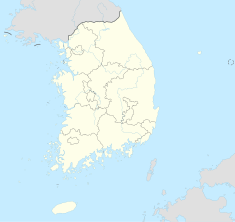| Seonjeongneung | |
|---|---|
 Jeongneung Jeongneung | |
| Location | Seoul, South Korea |
| Coordinates | 37°30′32″N 127°02′57″E / 37.50889°N 127.04917°E / 37.50889; 127.04917 |
| Governing body | Cultural Heritage Administration of Korea |
| UNESCO World Heritage Site | |
| Type | Cultural |
| Criteria | iii, iv, vi |
| Designated | 2009 (33rd session) |
| Reference no. | 1319 |
| Region | Asia and Australasia |
 | |
| Korean name | |
| Hangul | 선정릉 |
|---|---|
| Hanja | 宣靖陵 |
| Revised Romanization | Seonjeongneung |
| McCune–Reischauer | Sŏnchŏngnŭng |
Seonjeongneung is a burial ground from the Joseon dynasty, located in Seoul, South Korea. The westernmost tomb, called Seonneung, belongs to King Seongjong (1457–1494) the 9th monarch of Joseon. His first wife, Queen Gonghye of the Cheongju Han clan (1456–1474) died at age 18 and is buried near Munsan, north of Seoul. His third wife, Queen Jeonghyeon of the Papyeong Yun clan (1462–1530), is buried here because she gave birth to the future King Jungjong. Queen Jeonghyeon outlived Seongjong by 35 years and was buried in a splendid tomb to the east. Her grave has a stone fence encircling the mound, whereas her husband's tomb has a retaining wall. Statues of civilian and military officials and their horses stand at attention in front of the graves. South of the tombs is a single T-shaped shrine. There are also several auxiliary buildings for storing the materials used during commemorative ceremonies.
Queen Jeonghyeon had a deep interest in Buddhism and founded the nearby Bongeunsa Temple.
The other tomb is Jeongneung, located at the easternmost part of the site. This is the burial ground of King Jungjong (1487–1544), the 11th monarch of Joseon. He was the second son of Seongjong, and was originally buried in Goyang, near Munsan. However, his third wife, Queen Munjeong, thought it would be better to have him re-interred closer to his father. She expressed a wish to be buried alongside him, but this wish was never carried out, and his tomb stands alone.
See also
References
- "Seonjeongneung". Cultural Heritage Administration. Retrieved 2008-04-21.
- "Cultural Heritage Administration". Retrieved 2010-11-06.